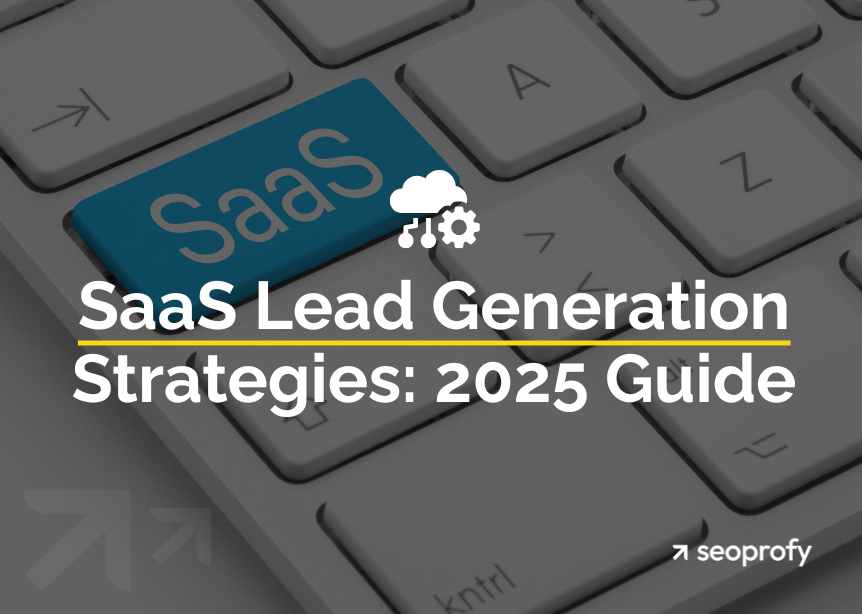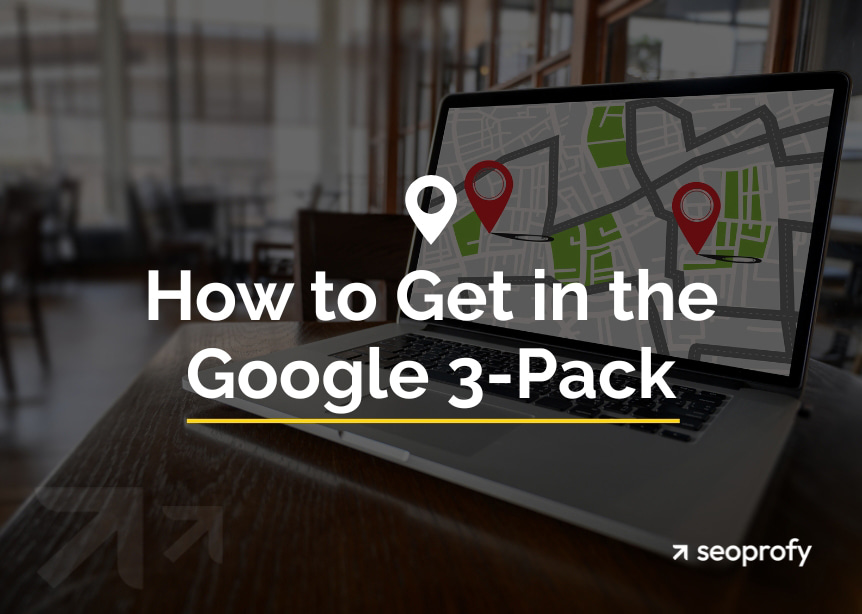Have you just launched an ecommerce website, and you want it to start generating income ASAP? Or, maybe you want to improve the existing performance of your online shop and catch the attention of new target customers. In both cases, opting for SEO for ecommerce products is a good idea!
It’s time to focus on product page SEO best practices to increase your visibility, traffic, and most importantly, sales. With the right optimization strategies, your ecommerce website can achieve astonishing results and secure long-term success. Our comprehensive guide will walk you through all the time-proven techniques to improve SEO for product pages and make this challenging process straightforward and manageable.
- The number one position on the first page of search results has an average click-through rate (CTR) of 28.5%, while the tenth position has only 2.5%.
- During product page optimization, it’s essential to pay attention to keywords, meta tags, headings, structure, product images, technical SEO, internal links, mobile optimization, CTAs, and backlink profile.
- A/B testing is a sure way to identify the CTAs that have the greatest impact on your customers.
- User-generated content can help you keep your ecommerce store active in the eyes of the search engines, improving its overall rankings.
- The optimal size of H1 headings on ecommerce websites’ pages is 60 characters.
- The average time for a mobile ecommerce site to load is 22 seconds, while its desktop version needs only 10.3 seconds.
Do You Really Need SEO for Ecommerce Product Pages?
Along with Google Ads and SMM, SEO for ecommerce product pages is one of the most popular digital marketing techniques. It aims to increase the visibility of your online store by making it rank higher in search results.
According to the studies, your site’s rankings have a direct influence on the click-through rate. For instance, the number one position on the first page of search engine results pages (SERPs) has an average CTR of 28.5%, while the tenth position has 2.5%.
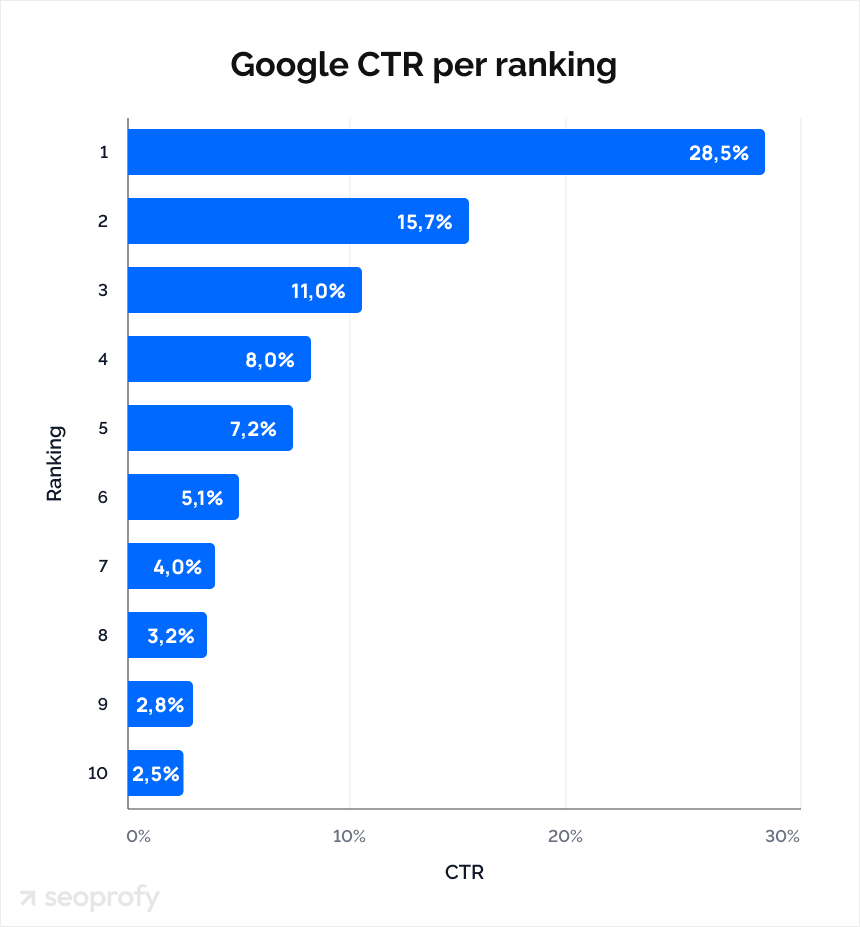
If you don’t want to get lost among your competitors’ websites, you need to implement ecommerce product page optimization. Effective SEO ensures you choose the right keywords and provide appropriate content to your target audience. By doing so, you can be confident that your online store attracts relevant customers who are more likely to make a purchase and drive its growth.
Where Can the Users See My Ecommerce Content on Google?
Before you start implementing your SEO campaign, it’s important to understand the areas where your content can appear. According to Google, there are several ways internet users can stumble upon your site:
- Google Search;
- Google Images;
- Google Lens;
- Business Profile;
- Google Maps;
- Google Shopping tab.
How SEO Affects Product Visibility and Sales
The benefits you can get from SEO for product pages are mind-blowing. Regardless of your niche, here’s how SEO can boost both your visibility and sales:
- Higher rankings: The creation of unique and valuable content with relevant keywords will undoubtedly increase your site’s position in SEPRs. This means that when a person looks for a product your online shop offers, there is a stronger chance that they’ll see your website and click on it.
- Increased sales: As SEO drives more relevant users to your site, the likelihood of conversions grows. The right strategy attracts visitors and encourages them to make purchases, directly impacting your sales.
- Enhanced technical performance: A comprehensive SEO audit can uncover and resolve technical issues affecting your site’s usability. Addressing these issues improves the user experience, positively impacts your rankings, and increases product visibility.
- Stronger backlink profile: A solid backlink strategy enhances your site’s authority and visibility. High-quality inbound links signal to search engines that your site is reputable and help attract more customers and increase sales.
The implementation of an efficient search engine optimization strategy requires profound knowledge and niche-specific experience. Thus, it’s a smart choice to opt for professional e-commerce SEO services to turn your site into a real lure for new customers.
Keyword Research for E-commerce Product Pages
Keyword research for ecommerce SEO is one of the most important processes during search engine optimization. First of all, you should discover the keywords related to your niche and target audience. Also, you may opt for specific phrases and words related to the area where your online business operates to increase your chances of catching customers’ attention from that region.
Targeting relevant keywords is essential if you want your ecommerce product page improvements to start driving more organic traffic. By implementing these words, you can be sure that it’ll attract users who are more likely to engage with your content. Thus, you’ll increase the time spent on your ecommerce product pages, lower the bounce rate, and get higher CTRs.
As a rule, you can divide the keywords into three types:
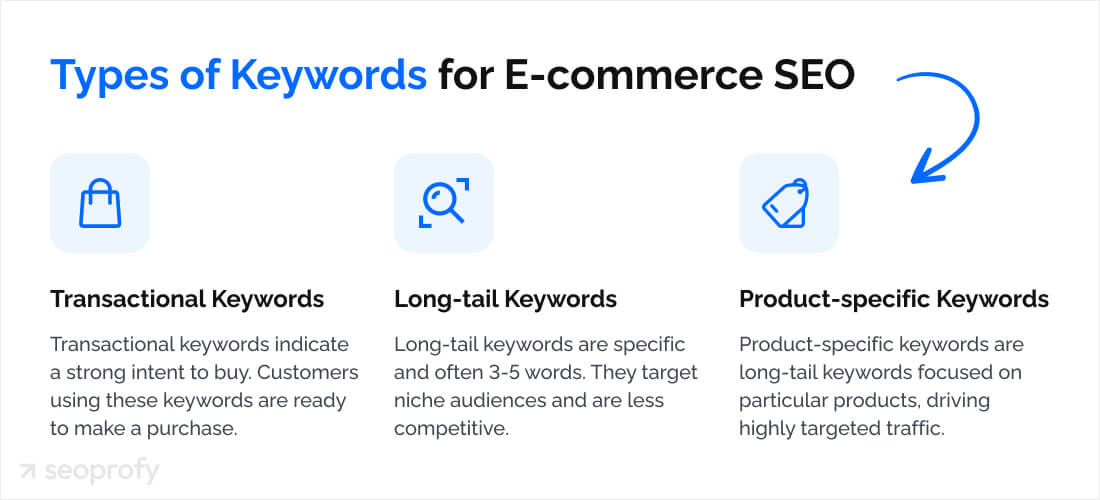
- Transactional: These are the phrases and words typed by the buyers when they’re surely going to make an online purchase. They usually have extremely strong commercial intent.
- Long-tail: These phrases include from three to five words. They’re generally more specific, allowing you to target the audience from a certain niche. Plus, long-tail product keywords are less competitive than others.
- Product-specific: This is a type of long-tail keyword that is more related to specific products. These words focus on driving more targeted traffic and increasing sales.
It’ll be a smart decision to analyze the keyword strategies implemented by your main competitors. That’s a great opportunity to define the most efficient tactics and the ways to beat the competition.
Discover Transactional and Long-Tail Product Keywords
Opting for both transactional and long-tail keywords is one of the best practices in SEO for successful conversion rate optimization (CRO). Such a smart approach will help you find users who are already ready to buy the products offered by your online store. Thus, converting them into paying customers will be way easier.
Optimize for Search Intent
Search engines place a high value on relevancy! So, if you want your ecommerce store to get spotted by the customer, you should focus on optimizing product pages for certain queries. Your keywords should align with the following search intents:
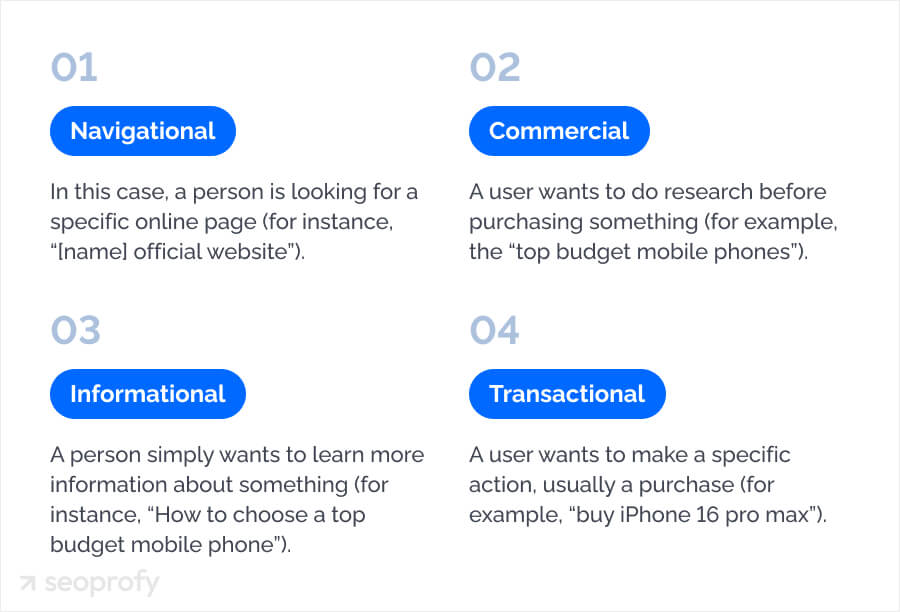
- Navigational: In this case, a person is looking for a specific online page (for instance, “[name] official website”).
- Commercial: A user wants to do research before purchasing something (for example, the “top budget mobile phones”).
- Informational: A person simply wants to learn more information about something (for instance, “How to choose a top budget mobile phone”).
- Transactional: A user wants to make a specific action, usually a purchase (for example, “buy iPhone 16 pro max”).
Using keywords with different search intent, you’ll be able to efficiently manage your content, attracting various types of customers and encouraging them to make purchases. If you don’t know how to deal with this task, get your SEO audit to discover the keywords that perfectly match your customer’s needs and interests.
Create SEO-Friendly Product Page Meta Tags
If you want your site to rank high, you should regularly analyze and improve the meta tags for ecommerce pages. Skillfully weave keywords into them and ensure they meet Google’s recommendations.
Optimize Title Tags
Here are some tips you can use to craft descriptive, keyword-rich titles. Use them to ensure the success of your SEO for e-commerce product pages:
- Include relevant keywords to help the search engines understand how your content is related to specific search queries.
- Never use similar titles for several pages.
- Follow one of the product page SEO best practices and opt for descriptive language to help the customers understand what they should expect from visiting your site.
- Always keep your titles concise and to the point.
Write Effective Meta Descriptions
You can also use the tips for meta titles while working on descriptions. In addition, if you want to maximize the impact of the SEO ecommerce product pages to succeed, include CTA in your meta descriptions. This is a great way to encourage customers to click on your website. The CTA may vary from a simple “Read now” to a more creative “Solve your problems today.” Remember to ensure that your meta title and meta description are of the correct length.
Optimize H1 Tags
Finally, never forget about the H1 tags while working on SEO for product pages. By structuring them and implementing main keywords, you’ll get interesting and readable texts, significantly improving the site’s performance and rankings. If you want your online store to catch the attention of search engines and customers, follow these tips while improving SEO for e-commerce product pages:
- Use only one per page;
- Ensure the tag is up to 60 characters long;
- Match your H1 with the search intent;
- Use action words and highlight the benefits of visiting your site;
- Make H1 tags similar to the title tags.
Structure E-commerce Product Pages for SEO
When a user visits your website, they may get irritated by its inconvenient navigation and poor structure of ecommerce product pages. Paying attention to these elements is essential if you want to increase your rankings and ensure customer satisfaction.
Optimize Product Descriptions
Check the descriptions of each product in your online store. Does it include relevant keywords and provide the solution to your customers’ issues? Also, if you want your product description optimization to bring truly jaw-dropping results, ensure the uniqueness of each text and eliminate any duplicate content on your website.
Use Clear and SEO-Friendly URLs
SEO-friendly URLs meet the requirements of search algorithms and the needs of your target customers. To optimize them during your ecommerce product page SEO campaign, rely on the best practices mentioned below:
- Include the keywords relevant to the page’s content;
- Separate the words using hyphens instead of spaces or underscores;
- Avoid upper case letters and special characters;
- Opt for static URLs instead of dynamic ones;
- Always use HTTPS.
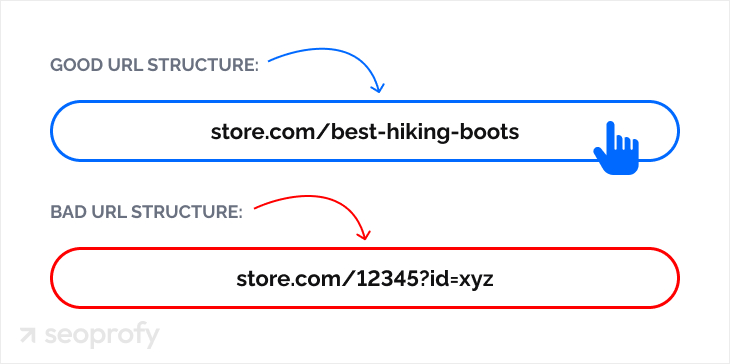
Apply Breadcrumbs for Better Navigation and SEO
If you wonder what “breadcrumbs” or a “breadcrumb trail” is, recollect the story about Hansel and Gretel, who used breadcrumbs to return to their home. When it comes to SEO for product pages, this term describes a secondary navigation scheme that helps the user navigate through your website. For example, when a person finds your site’s page in search results, they can use breadcrumbs to continue exploring your online store. Following them, the customers can get acquainted with product categories, check the related goods, or return to the homepage.
Breadcrumbs are important for ensuring an ideal user experience, lowering bounce rates, and improving engagement. Moreover, they are an integral part of SEO for e-commerce product pages. By incorporating them into your website’s navigation system, you’ll provide your visitors with a clear way back to the homepage. Plus, the search engine crawlers will also appreciate the enhanced site structure.
Structured Data for Product Pages
Many owners of ecommerce websites wonder why structured data for product pages is essential. The primary benefit is that it clarifies the content on your pages. This makes it easier for search engines to interpret what your products are about. As a result, they can display more engaging, information-rich search results, which attract prospective customers and encourage them to interact with your site.
Implement Product Schema Markup
Product schema markup is an essential part of SEO for ecommerce product pages. This is a code that provides the search engines with information about your specific page, its elements, and how users are supposed to see it. Ensure the success of your ecommerce product page SEO campaign by implementing the schema markup with the help of this simple instruction:
- Visit Google’s Structured Data Markup Helper.
- Choose the appropriate type of data (for example, “Products”).
- Paste the URL of the page you want to mark up.
- Select the element to mark up.
- Create the HTML.
- Go into your site’s CMS and add the schema markup.
Use Rich Snippets to Improve CTR
Rich snippets for product listings can significantly increase visibility. For instance, if your website includes pages with proper schema markups, it can display the reviews, availability, and prices directly in search results.
Due to this SEO technique, you can get more search impressions, as your content will become more visible in SERPs. Considering that more users will see your pages, there is a strong chance that CTRs will increase, too.
Apply FAQs Schema for Additional Visibility
You may also implement the FAQ schema while optimizing product pages. This is not only a good way to answer common customer questions but also to increase your site’s visibility.
The FAQ schema turns the information you provide into a rich snippet that appears on the Google SERP. This means that users will be able to see it even without visiting your website. At the same time, if you provide valuable and unique content, there is a strong chance that a person will visit your online store to learn more.
Optimize Images and Visual Content
It’s impossible to run a successful ecommerce website without high-quality images. These visual elements help your customers make a final decision on a purchase. Thus, enhancing your images is also important when it comes to SEO for e-commerce product pages.
Use Alt Text for Product Images
Image alt text optimization helps search engines understand the graphic elements on your pages. It helps increase the overall ranking of your ecommerce website. Thus, always check whether your images’ alt texts include keywords naturally woven into the most important information related to the products you sell.
Optimize Image Size and Format
Page load speed for ecommerce is a decisive factor that impacts your users’ experience, bounce rates, and ranking. According to Backlinko, the average time for a mobile site to load is 27.3 seconds, while its desktop version needs only 10.3 seconds. Unfortunately, poorly optimized images may significantly affect this time.
While implementing your ecommerce product page SEO campaign, take time to check all the graphic elements on your website. An optimal size for such pictures is 640×640 or 800×800. The best formats to ensure fast loading of your pages without affecting the image quality include AVIF, JPG, WebP, JPEG, and PNG.
Include Product Videos for Enhanced User Engagement
When you start optimizing your pages with products, don’t forget to add some product videos. Due to the smart implementation of exciting footage, you can keep your customers on your pages longer. It will be a signal for search algorithms that your site offers interesting and valuable content. Moreover, the increased dwell time will boost your SEO and rankings.
Arrange User-Generated Content for SEO
When talking about SEO for ecommerce product pages, it’s impossible not to mention the importance of content generated by your buyers. The positive reviews, ratings, and photos will not only contribute to your site’s ranking but also make it more reputable in the eyes of other prospective customers.
Encourage Customer Reviews and Ratings
No one can deny the importance of user reviews for SEO. Google’s algorithms appreciate fresh and regularly updated content because it indicates that a website is active.
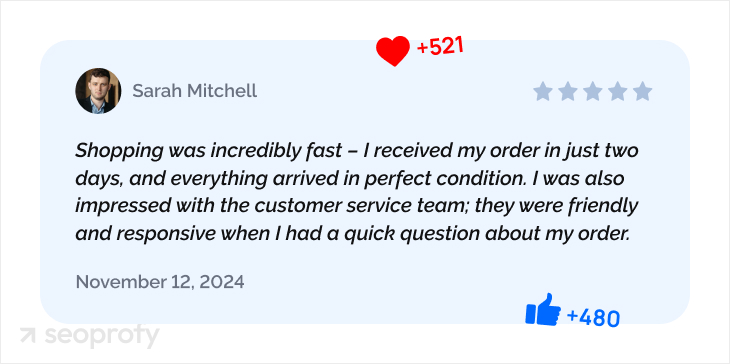
When a person describes their customer experience on product pages of your website, the search engines see that your site engages with the audience, which is a positive ranking factor. Additionally, customer feedback can help you build trust with other potential buyers.
Utilize Customer Photos and Testimonials
Your users’ photos and testimonials are another type of fresh content that can keep high activity on your ecommerce website, boosting your SEO product page efforts. Additionally, the UGC (user-generated content) offers you a variety of other advantages, including:
- Increased local engagement and visibility;
- Audience retention;
- Creation of a loyal community;
- Enhanced brand’s credibility;
- Useful insights related to your customer’s preferences.
Mobile Optimization for E-commerce Product Pages
According to Statista, nearly 59% of all website traffic worldwide is generated by mobile phones. If you want to run a successful online business, your website should include mobile-friendly product pages.
Ensure Mobile-Friendly Design
Considering the popularity of mobile devices, it’s no wonder that you should perfectly optimize your pages for all modern devices. When it comes to SEO, mobile optimization contributes to your site’s rankings as it helps your online store display appropriately on various gadgets. Further, Google’s bot always uses the site’s mobile version as a starting point for crawling. And, of course, this factor influences user experience, navigation, and bounce rates.
Optimize for Mobile Search Behavior
The research conducted by eMarketer discovered that 8% of US adults use voice search instead of traditional Google search to shop regularly. At the same time, this number rapidly grows, so if you want your online business to flourish, you should adapt your SEO strategy to this trend.
Furthermore, keep in mind that people typically opt for mobile devices while looking for goods and services in their area. A great way to take advantage of this trend is to optimize pages to such unique local queries. You can do it by optimizing your site’s code, compressing images, simplifying navigation, and creating easy-to-read content with properly placed links.
Accelerate Mobile Page Load Times
Google claims that most mobile site visitors leave a page if it takes over three seconds to load. That’s why it’s a wise decision to include the implementation of the AMP (Accelerated Mobile Pages) in your SEO campaign. Unlike usual pages, they are designed to overcome common coding issues that cause a slow loading speed.
The good news is that AMP pages use traditional web technologies, which means you can create them without changing your current development workflow. For instance, you may opt for Google Web Designer to deal with this task within a week during your ecommerce product page enhancement.
Technical SEO Considerations for Product Pages
Sometimes, even the tiniest technical issue may stand between your site and high rankings. If you want your website’s SEO product page improvements to bring convincing results, you need to conduct a technical audit. However, without proper knowledge and experience, there is a chance you may miss something.
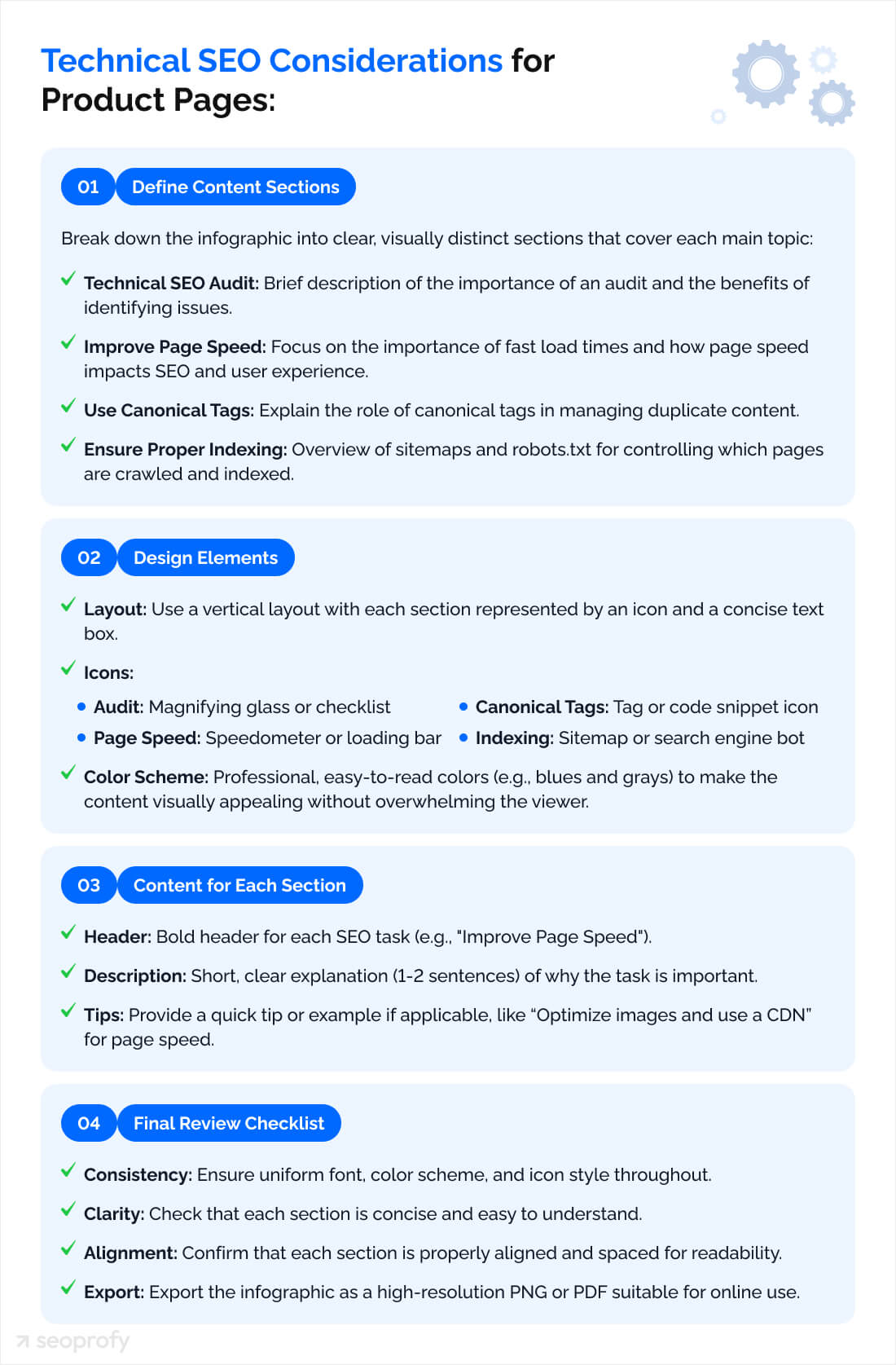
Fortunately, SeoProfy is here to lend a helping hand! Our experts will check each corner of your site to identify the tiniest problems. After that, we’ll provide you with efficient solutions to each of the discovered issues. Conduct your website’s checkup with our team to enjoy the benefits of a flawless ecommerce store:
- High search rankings
- Boosted website traffic
- Increased sales and customer retention

Improve Page Speed
Page speed is one of Google’s important ranking factors. It means that even a delay of several seconds may significantly lower your site’s position in SERPs, decreasing its online visibility and traffic.
Furthermore, site speed has a direct impact on user experience and bounce rates. You undoubtedly should pay attention to these metrics while optimizing product pages and figure out how to improve them. Turning your ecommerce store into a fast-loading website will help you dominate the rankings and boost sales conversions.
Use Canonical Tags to Avoid Duplicate Content
The usage of canonical tags allows you to indicate to search algorithms that specific URLs represent the main copy of your site’s pages. This is a powerful tool that can help you deal with duplicate content issues.
You can define the canonical URL in the <head>-section or HTTP header. Remember that there may be only one canonical URL per page.
Ensure Proper Indexing
Sitemaps are XML files that include your site’s URLs and important pieces of information about them, including the last changes, page priorities, etc. Using Google Search Console, you can submit and monitor these sitemaps to ensure that search engines accurately index the ecommerce product pages.
Also, there are robots.txt files that provide the algorithms with instructions on which pages or directories they can or cannot crawl. Thus, you can control access to your content and prevent low-quality pages from crawling and indexing.
If you want to implement a successful SEO product page campaign, you should pay attention to these important elements, too. That’s how you can enhance your online shop’s relevance, indexability, and crawlability. Regularly spend time making sure that all your sitemaps are accurate and updated.
Internal Linking and Related Products
The importance of internal linking for ecommerce sites is undeniable. You can use these elements to ensure your visitor’s smooth journey through multiple categories, blog posts, and product descriptions. Here are more details on the issue.
Link to Related Products and Categories
It’s not enough to simply put a couple of links in your most popular blog post and expect the success of your SEO product page campaign. You should follow time-tested principles if you want to get favorable search engine optimization outcomes:
- Provide links to corresponding category pages.
- Define which pages are the most important for driving conversions and try to refer to them in your content.
- Always check your internal links to ensure there are no broken ones.
- Thoughtfully refer to other pages in the text so they can provide your customers with additional information about this or that product or service.
Of course, if you run a website with dozens of categories and thousands of offers, it may be extremely challenging to manage all internal links. That’s where SeoProfy comes into play! On-page optimization is one of our professional enterprise SEO services, which will help you finally get all the elements of your ecommerce website organized.
Cross-Sell and Upsell with SEO-Friendly Links
Complementary and higher-value products are the items that can significantly enhance the value of the main purchase, so it’ll be a smart decision to place internal links to their pages. The implementation of this SEO product page strategy can dramatically increase sales and the average order value. Consider that your buyers will be more likely to opt for additional items when you conveniently suggest them during the purchase process. This approach also helps search engines understand product relationships, which can enhance the SEO value of internal links.
Use Anchor Text for Internal Links
Finally, during your SEO product page improvement, ensure that you’ve used the right anchor texts for your internal links. It should provide the users with a clear idea of what they’ll see if they click on it. For example, if they click on “the best mobile phones 2024”, the link must take them to the page with the top newest mobile phones.
Call-to-Action (CTA) Optimization for SEO
Call to action (CTA) optimization is essential for ecommerce product pages as this element encourages the buyer to make a purchase. It usually stands out from other content on a page due to contrasting text and eye-catching graphics.
Use Clear, Compelling CTAs
While performing an ecommerce product page optimization, you should undoubtedly focus on improving CTAs. Make sure they follow these general principles:
- Your “Buy Now” and “Add to Cart” buttons must be easy to find. Place them prominently on the page so the users can spot them without any difficulties.
- Use clear text. When optimizing product pages in ecommerce stores, it’s better to use short phrases for your CTAs. Don’t opt for confusing words because your customers should understand what actions they are taking right away.
- Increase conversions through urgency. In some cases, you can enhance the effectiveness of your CTAs by using phrases like “Only a few left in stock” or “Limited Time Offer” to emphasize the product’s scarcity.
Add CTAs to Meta Descriptions
You can place your CTAs not only on a page but also in its meta description. Usually, they end the sentence by motivating a user to click on your website, sign up for a service, make a purchase, or take any other action you need. Thus, CTAs can drive not only higher CTRs but also significantly increase your sales.
Test and Refine CTA Placement
Last but not least, if you want to improve the SEO of your pages, you should constantly analyze the performance of your CTAs. Always use A/B testing during your SEO product page campaign. This method allows you to experiment with your call-to-action buttons. For example, you can change their color, placement on a page, text, etc.
By analyzing the results, you can identify which CTA drives the most conversions. After that, you can use it across all ecommerce product pages on your site to ensure maximum impact on your customers.
Conclusion
Remember that SEO is a never-ending marathon, so you should always keep an eye on the latest trends and changes in Google’s algorithms. If you don’t want to ruin the result of your search engine optimization, you should regularly check all the product pages on your e-commerce site. Make sure they provide relevant information and meet all Google’s requirements. Following this simple yet effective rule, you can keep your online store flourishing and conquering new horizons!










